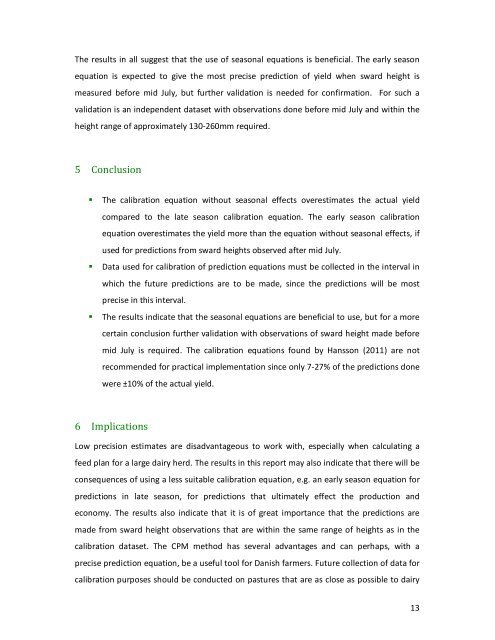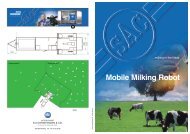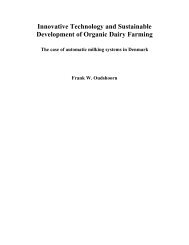Validation of Calibration Equations Developed ... - Automatic Milking
Validation of Calibration Equations Developed ... - Automatic Milking
Validation of Calibration Equations Developed ... - Automatic Milking
You also want an ePaper? Increase the reach of your titles
YUMPU automatically turns print PDFs into web optimized ePapers that Google loves.
The results in all suggest that the use <strong>of</strong> seasonal equations is beneficial. The early season<br />
equation is expected to give the most precise prediction <strong>of</strong> yield when sward height is<br />
measured before mid July, but further validation is needed for confirmation. For such a<br />
validation is an independent dataset with observations done before mid July and within the<br />
height range <strong>of</strong> approximately 130-260mm required.<br />
5 Conclusion<br />
The calibration equation without seasonal effects overestimates the actual yield<br />
compared to the late season calibration equation. The early season calibration<br />
equation overestimates the yield more than the equation without seasonal effects, if<br />
used for predictions from sward heights observed after mid July.<br />
Data used for calibration <strong>of</strong> prediction equations must be collected in the interval in<br />
which the future predictions are to be made, since the predictions will be most<br />
precise in this interval.<br />
The results indicate that the seasonal equations are beneficial to use, but for a more<br />
certain conclusion further validation with observations <strong>of</strong> sward height made before<br />
mid July is required. The calibration equations found by Hansson (2011) are not<br />
recommended for practical implementation since only 7-27% <strong>of</strong> the predictions done<br />
were ±10% <strong>of</strong> the actual yield.<br />
6 Implications<br />
Low precision estimates are disadvantageous to work with, especially when calculating a<br />
feed plan for a large dairy herd. The results in this report may also indicate that there will be<br />
consequences <strong>of</strong> using a less suitable calibration equation, e.g. an early season equation for<br />
predictions in late season, for predictions that ultimately effect the production and<br />
economy. The results also indicate that it is <strong>of</strong> great importance that the predictions are<br />
made from sward height observations that are within the same range <strong>of</strong> heights as in the<br />
calibration dataset. The CPM method has several advantages and can perhaps, with a<br />
precise prediction equation, be a useful tool for Danish farmers. Future collection <strong>of</strong> data for<br />
calibration purposes should be conducted on pastures that are as close as possible to dairy<br />
13




